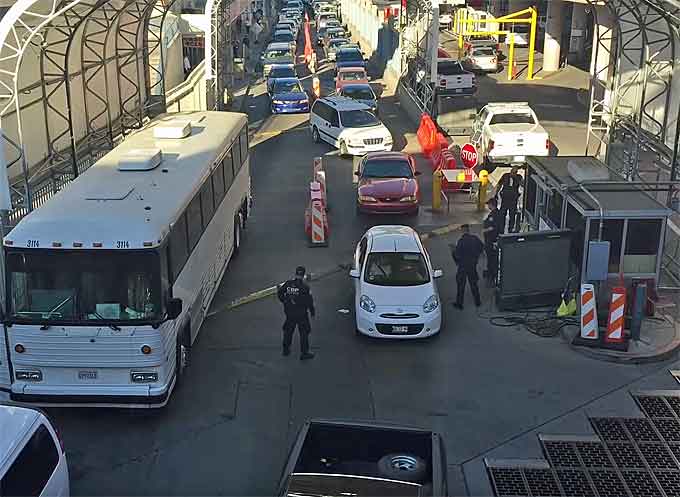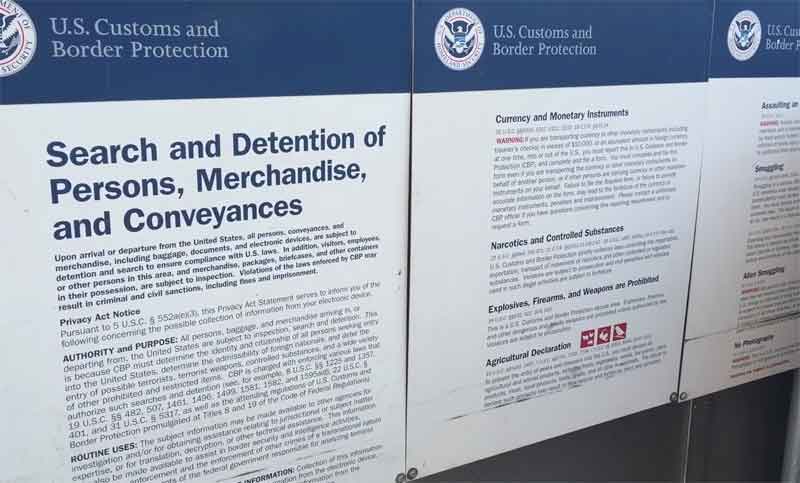
By Russell Brandom, The Verge
The week after the 2016 election, drivers exiting the United States at the Nogales border crossing would have noticed something out of the ordinary.
A new canopy had been set up over the far-right lane of the checkpoint with an ad-hoc wiring system supporting multiple DSLR cameras.
The cameras were trained at the road and activated by an array of ambient light sensors, range finders, and remote speedometers.
As cars approached the turnstile, the cameras would capture a clear shot of the driver’s face through the windshield, images that researchers would later use to develop an experimental facial recognition system designed for use at the border.
Now, that system is getting ready for a more permanent installation.

In August, Customs and Border Protection will deploy a new system for scanning drivers’ faces as they leave the US, The Verge has learned.
The pilot, called the Vehicle Face System (or VFS), is planned for installation at the Anzalduas border crossing at the southern tip of Texas and scheduled to remain in operation for a full year.
The project is currently moving through the necessary privacy reviews, and it is set to be officially announced and submitted to the Federal Register in the coming months.
According to a Customs spokesperson, the purpose of the project will be “to evaluate capturing facial biometrics of travelers entering and departing the United States and compare those images to photos on file in government holdings.”
The new pilot is the result of years of effort by Customs and Border Protection to develop a camera capable of recognizing faces through the windshield of a car, a long-standing challenge for facial recognition systems.
The project is part of the broader Biometric Exit program, which seeks to physically verify visa-holders’ identities as they leave the country.
The largest arm of that program has been the installation of facial recognition systems at airports, which are currently being piloted in New York, Los Angeles, and six other major cities.
(Learn More. Your face is now your boarding pass under a new system being tested out at LAX that uses biometric facial recognition technology at a flight’s gate. Courtesy of FOX 11 Los Angeles and YouTube. Posted on Jan 19, 2018)
Enforcing biometric exit at land borders has been more challenging, but customs officials hope that more sophisticated cameras could allow similar facial recognition systems to be used at land borders.
Tests related to the new camera have been underway since 2016, initially in collaboration with Oak Ridge National Labs in Tennessee.
Documents obtained by The Verge through a Freedom of Information Act request show that Oak Ridge performed tests at two border crossings in connection with the project: first at Nogales, Arizona from November 14th to 17th, then at and Anzalduas, Texas, from January 9th to 13th.
The tests, which have never been publicly revealed, collected images and video from roughly 1,400 vehicles at each crossing. The images were analyzed for their suitability for facial recognition, but officials say they weren’t shared with Customs or otherwise used for identification.
The VFS project is based on plenoptic technology, which allows a single sensor to capture images at multiple focal lengths simultaneously, similar to the Lytro and other depth-field cameras.
(Learn More. Once the stuff of science fiction, facial-scanning cameras are becoming a part of daily life in China, where they’re used for marketing, surveillance and social control. Courtesy of Paolo Bosonin, Qilai Shen, Bloomberg, The Wall Street Journal and YouTube. Posted on Jun 27, 2017.)
Traditional facial-recognition systems are often confused by the moving reflections in a car windshield, which make it difficult to isolate facial features.
Researchers working on in-car recognition hope that the right focus would separate the driver from the reflections.

In the 2016 tests, images were collected through conventional DSLR cameras set up for multiple focal lengths across both the visible and infrared spectra to simulate plenoptic capabilities.
The ad hoc nature of the tests also meant that data was collected with no particular scrutiny of more or less suspicious travelers.
A report from the Nogales tests describes capturing the afternoon rush hour, “as people were leaving work, picking up children from school, and carrying out other daily routines.”
Documents show that the ORNL researchers did obtain IRB approval, although images were collected under existing CBP authorities for data collection at the border, and drivers were not notified that the test was taking place.
The Vehicle Face System will go further than those tests, aiming to capture a facial recognition-ready image for every passenger in every car in both the inbound and outbound lanes.

Those images will be matched against visa and passport photos already on file with CBP, verifying travelers before they even reach the turnstile.
Still, it remains to be seen how well the system will function in practice and how widely it can be deployed.
The prospect of widespread in-car facial recognition has already raised concerns with civil liberties groups, who worry that it could open the door to more widespread surveillance.
“This is a way for the federal government to track people – monitoring who goes where and what they do there,” said Mitra Ebadolahi, a staff attorney with the ACLU’s Border Litigation Project.
“In a free society, we should all be able to safely live our lives without being watched and targeted by the federal government.”
Original post https://www.theverge.com/2018/6/5/17427150/facial-recognition-vehicle-face-system-homeland-security-immigration-customs
CBP Recognized in the 2017 ‘ASTORS’ Homeland Security Awards Program
-
U.S. Customs and Border Protection
- CBP Entry/Exit Program Aims to Implement a Biometric Exit System that Enhances Security, Minimizes the Impact to Travelers, Control Costs and Safeguards Travelers Privacy
- Excellence in Homeland Security
AST focuses on Homeland Security and Public Safety Breaking News, the Newest Initiatives and Hottest Technologies in Physical & IT Security, essential to meeting today’s growing security challenges.
 The annual ‘ASTORS’ Homeland Security Awards Program, is organized to recognize the most distinguished vendors of Physical, IT, Port Security, Law Enforcement, Border Security, First Responders, (Fire, EMT, Military, Support Services Vets, SBA, Medical Tech) as well as the Federal, State, County and Municipal Government Agencies – to acknowledge their outstanding efforts to ‘Keep our Nation Secure, One City at a Time.’
The annual ‘ASTORS’ Homeland Security Awards Program, is organized to recognize the most distinguished vendors of Physical, IT, Port Security, Law Enforcement, Border Security, First Responders, (Fire, EMT, Military, Support Services Vets, SBA, Medical Tech) as well as the Federal, State, County and Municipal Government Agencies – to acknowledge their outstanding efforts to ‘Keep our Nation Secure, One City at a Time.’
To Learn More about the ‘ASTORS’ Homeland Security Awards Program, see 2017 ‘ASTORS’ Homeland Security Award Winners Honored at ISC East.

Over 100 distinguished guests from National, State and Local Governments, and Industry Leading Corporate Executives from companies allied to Government, gathered from across North America and the Middle East to be honored from disciplines across the Security Industry in their respective fields which included representatives from:
- The Department of Homeland Security
- The Department of Justice
- The Security Exchange Commission
- State and Municipal Law Enforcement Agencies
- Leaders in Private Security
- Nominations are now being accepted for the 2018 ‘ASTORS’ Homeland Security Awards at https://americansecuritytoday.com/ast-awards/.
U.S. Customs and Border Protection Entry/Exit Program
In 2004, Congress required DHS to develop a biometric entry and exit system. In 2013, Congress transferred the entry/exit policy and operations to U.S. Customs and Border Protection (CBP).


















